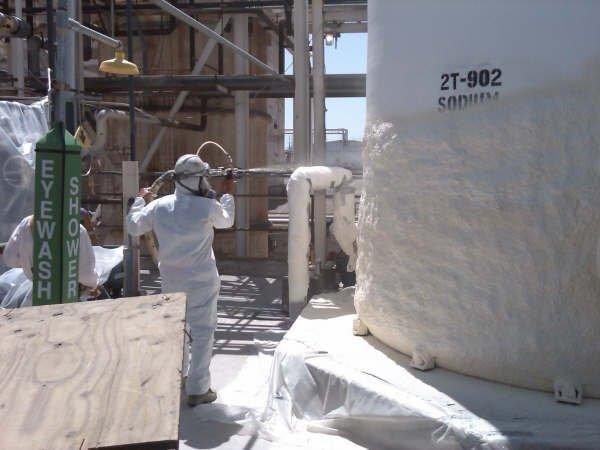Rigid Building Foams
Quick Overview
Rigid Building Foams offer a unique blend of properties which yield excellent mechanical and thermally efficient structures. SSFR foams deliver high compressive/shear strength, insulating capacity, overall toughness and impact resistance. Their high performance strength to weight ratio densities produce a wide range of applications for very diverse industries. As an energy saving material yielding very high insulating values, paralleled with its sound absorbing capability it has seen much use in the architectural and construction industries. Rigid foams are applied in spray or casting formats. Pour casting diversifies its uses to the areas of consumer products manufacturing, mold making, marine docks, flotation, void fill, artwork carving and many industrial and commercial industries. SSFRs may be subsequently color top-coated, textured and clear coated to handle extensive outdoor rugged environments using the ClearSkin system. These materials maintain dimensional stability and will not deform or distort within operating temperature of -100F to 200F. Fire retardant formulations are used in structural public buildings and warehouses. Installation cure times range from 30 sec. to 30 min. depending on application method (spray vs. pour), ambient temperature and humidity. Pour foam applications require longer cure times and caution must be taken for large castings due to inherent exothermic reaction process. SSFRs utilize a standard 2-component liquid pumping machine for both the spray and pour methods of dispensing. Volumetric expansion of SSFR may be formulated up to 140x relative to its original volume depending on required application densities. Densities of 2-3 pcf have been tested to MIL-P21929C.
The Rigid Building Foams are water or gas blown (245 or Pentane) fast-set materials typically used for air-tight insulation applications due to their closed-cellular nature. These foams are premium building products which contribute structural integrity with moisture, air and chemical vapor barrier integrity. High insulating values are attibuted with these foams and as such are commonly in roof, wall and floor insulation applications, commercial freezers and all energy saving applications where high thermal insulating requirements are mandated. Values vary relative to foam densities. Foam coverage per sq.ft. will vary relative to the density also as governed by expansion characteristics, the ambient spray temperature and the substrate temperature.
Please contact our Customer Service and Technical Support Group for any questions or to provide direction with specific selection of a material system, questionalable target surfaces, operational procedures, material pumping/spray machines, spray/pour guns, safety protection gear and clean-up kits.
Technical Application Data
Both SuperSkinFoam types normal require a two component dispensing machine. Rigid foams may also be hand batch mixed in small volumes. Large volume batch mixing requires special formulation. Cure times of for spray Elastomerics range from 20-30s while Rigid spray foams range 10-60s. During application, to obtain heavier build thickness, it is important to apply a heavy one-pass delivery. Do not dispense multi-passes as pinholing will occur. For best foaming results, it is best to pre-heat material in drums to 75°F and proportional machine to 110°F. Substrate must be dry while relative humidy < 85%. Volumetric expansion of Elastomerics provide up to 4x original volume while Rigids may expand up to 100x depending on foam density. Elastomeric foams may be applied from 40°F to 100°F in high humidity climates with target surfaces clean and moisture free. Rigid foams may be applied from 70 F up to 100 F under the same conditions. Both foams may be formulated to fire retardant Class 1 E84 ASTM standard for industrial use. Rigids will handle 200 F service operation temperatures while Elastomerics may extend up to 250 F. These foams yield excellent adhesion characteristics and are extremely water repellent. Elastomerics retain a high resilentcy to impact and foot traffic compared to Rigids which exhibit compression set under load. Both foams require a UV protective top-coating for exterior weatherability applications.
Physical Properties
| Rigid Building Foams Physical Properties | ||||||||||
|---|---|---|---|---|---|---|---|---|---|---|
| DENSITY (PCF) | ASTM D1622 | 0.5 | 1.0 | 1.5(1.5) | 2(2.0) | 2.5(2.5) | 3(3) | 6(6) | 10(10) | |
| Fire Rating | ASTM E84 | Class 1 | Class 1 | Class 1 | Class 1 | Class 1 | Class 1 | Class 1 | Class 1 | |
| Thermal Resistance (Rvalue) | ASTM C518 | 3.6 | 4 | 4.5(5.7) | 4.7(6.8) | 4.7(6.8) | 4.7(6.5) | 4.7(5.5) | 4.7(5.0) | |
| Compressive Strength (psi) | ASTM D1621 | 12 | 14 | 15 | 25 | 37 | 50 | 100 | 201 | |
| Shear Strength (psi) | ASTM C273 | 15 | 17 | 18 | 22 | 26 | 35 | 85 | 127 | |
| Shear Modulus | ASTM C273 | 185 | 195 | 207 | 231 | 253 | 312 | 788 | 1011 | |
| Tensile Strength (psi) | ASTM D1623 | 20 | 25 | 30 | 40 | 44 | 62 | 165 | 227 | |
| Flexual Strength (psi) | ASTM C203 | 35 | 40 | 45 | 55 | 65 | 123 | 204 | 312 | |
| Flexual Modulus | ASTM C203 | 111 | 145 | 164 | 522 | 963 | 2356 | 4785 | 7055 | |
| Water Absorption (%vol) | ASTM D2842 | <5.0 | <5.0 | <1.0 | <0.5 | <0.1 | <0.1 | <0.1 | <0.1 | |
| Water Vapor (perm-in) | ASTM E96 | <5.0 | <5.0 | <1.0 | <1.0 | <1.0 | <1.0 | <1.0 | <1.0 | |
| Fungi Resistance | ASTM C 1338 | None | None | None | None | None | None | None | None | |
| Closed Cell Content (%) | ASTM D2856 | Open | >40 | >85 | >90 | >90 | >95 | >95 | >95 | |
| NOTE: Gas-Blown foam property values are indicated (value) | ||||||||||


Reviews
There are no reviews yet.